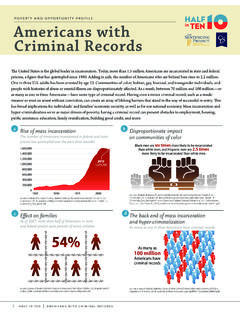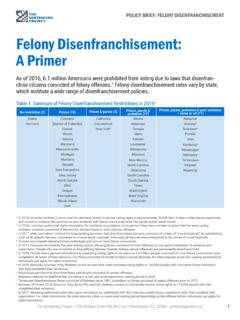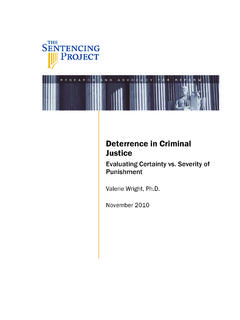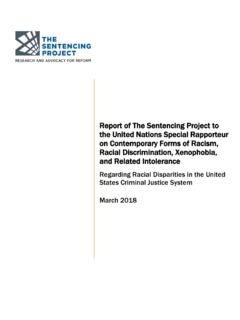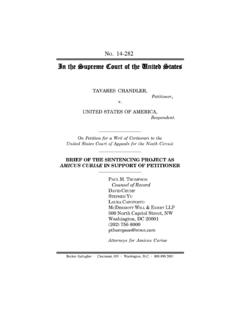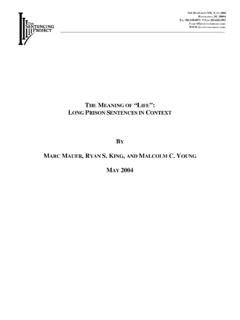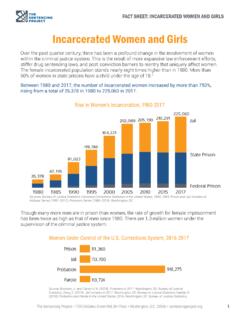Transcription of FEDERAL CRACK COCAINE SENTENCING
1 FEDERAL CRACK COCAINE SENTENCING . Overview On August 3, 2010 President Obama signed the Fair SENTENCING Act, legislation that limits the stiff mandatory minimum sentences for low-level CRACK COCAINE offenses that bipartisan leaders agree were overly harsh and unjust. The new law significantly reduces the COCAINE SENTENCING quantity disparity from 100 to 1 to 18 to 1 by raising the quantity of CRACK COCAINE necessary to trigger the five- and ten- year mandatory minimum sentences first set in 1986. The legislation also eliminates the mandatory minimum for simple possession of CRACK COCAINE . The bill passed unanimously through the Senate and by voice vote with little opposition in the House. The reform marks progress towards ensuring fairness and proportionality in FEDERAL SENTENCING in an arena where a mandatory minimum sentence has not been eliminated since the 1970s and bipartisan agreement to reduce penalties, particularly for drug offenses, is rare.
2 As introduced, the Fair SENTENCING Act's provisions would have completely eliminated the SENTENCING disparity between CRACK and powder COCAINE and its impact in reducing racial disparity and growing FEDERAL incarceration rates would have been more dramatic. The Senate Judiciary Committee's consideration of the bill resulted in the 18 to 1 compromise that ultimately passed the Congress. The new law does not allow for retroactive application, so persons currently incarcerated or awaiting SENTENCING for CRACK COCAINE offenses committed before enactment will not benefit from the changes to the mandatory minimums. While changes created by the Fair SENTENCING Act are profound, the original concerns expressed by advocates regarding the excessiveness of punishments for relatively low-level CRACK COCAINE offenses and the continued SENTENCING disparity between two forms of the same drug remain.
3 Moreover, the significant racial disparity in FEDERAL prisons will continue. This briefing paper provides background on the COCAINE SENTENCING debate, explores the racial impact of the CRACK SENTENCING disparity, and clarifies the misperceptions regarding CRACK addiction. Origins of FEDERAL COCAINE SENTENCING Policy CRACK COCAINE became prevalent in the 1980s and received extensive media attention, due in part to its exponential growth in the drug market. The popularity of CRACK COCAINE was associated with its cheap price, which for the first time made COCAINE available to a wider economic class. CRACK is made by taking powder COCAINE and cooking it with baking soda and water until it forms a hard rocky substance.
4 These rocks are then broken into pieces and sold in small quantities. Public concern about CRACK COCAINE addiction and its accompanying violent drug market spread quickly. Newscasters used words like crisis and epidemic - later shown to be exaggerated - to describe the impact of CRACK . The drug was considered a social menace more dangerous than powder COCAINE in its physiological and psychotropic effects. The political hysteria that ensued led Congress 1705 DeSales St. NW, 8th Floor, Washington, DC 20036 Tel. Fax to pass the Anti-Drug Abuse Act of 1986. The law's mandatory penalties for CRACK COCAINE offenses were the harshest ever adopted for low level drug offenses and established drastically different penalty structures for CRACK and powder COCAINE .
5 Under the resulting law, defendants convicted with just five grams of CRACK COCAINE , the weight of less than two sugar packets and a quantity that yields about 10 to 50 doses, were subject to a five-year mandatory minimum sentence. The same five-year penalty was triggered for the sale of powder COCAINE only when an offense involved 500 grams, 100 times the minimum quantity for CRACK , which yields between 2,500 and 5,000 doses. 1 Similarly, while the sale of 5,000 grams of powder, which can yield up to 50,000 doses, subjected defendants to a 10-year sentence, the same mandatory sentence was triggered by selling only 50 grams of CRACK , which produces about 100 to 500 doses. In 2009, this mandatory SENTENCING structure resulted in average sentences for CRACK COCAINE offenses that were over two years longer than for offenses involving powder Under the Fair SENTENCING Act of 2010, defendants convicted of a CRACK COCAINE offense will now need to possess at least 28 grams, compared to the previous five grams, to receive a five-year mandatory minimum.
6 To trigger the 10-year mandatory minimum requires a CRACK COCAINE quantity of 280 grams. Quantity triggers for powder COCAINE offenses remain the same. The simple possession mandatory minimum for a first-time offense is eliminated under the reformed law. First-time simple possession of any quantity of CRACK COCAINE , like powder COCAINE , will result in a sentence no longer than one year. Previously, a person convicted in FEDERAL court of simple possession of 5 grams of CRACK was subject to a mandatory five-year prison term. Figure 1 highlights the differences in average sentences between CRACK and powder COCAINE during fiscal year 2009 compared to the projected differences in sentence length after passage of the Fair SENTENCING Act.
7 The average CRACK COCAINE sentence will decline by 14 months but CRACK COCAINE sentences will average 14 months longer than powder COCAINE sentences. The SENTENCING Commission's projections also find an average sentence reduction of 27 months among cases likely to be affected by the 2010 reforms, which comprise about 63% of CRACK COCAINE cases sentenced each 1. United States SENTENCING Commission [USSC], Report to Congress: COCAINE and FEDERAL SENTENCING Policy (May 2007), p. 73. 2. United States SENTENCING Commission, 2009 Sourcebook of FEDERAL SENTENCING Statistics, Figure J. 3. USSC, Prison Impact Model, FY2009 datafile 2. Figure 1: Average Sentences for CRACK COCAINE and Powder COCAINE Pre FSA.
8 Timefrace CRACK COCAINE Powder COCAINE Post FSA. 0 20 40 60 80 100 120 140. Months SOURCE: SENTENCING Commission, 2009 Sourcebook of FEDERAL SENTENCING Statistics and Prison Impact Model, FY2009 datafile Drug Quantities and CRACK COCAINE Penalties The FEDERAL SENTENCING laws Congress passed in the 1980s were intended to impose tough sentences on major drug market operators, such as manufacturers or heads of organizations distributing large quantities of narcotics, and serious traffickers with a substantial drug-trade However, the weights attached to the sentences failed to capture the different roles within the CRACK trade. Research from the SENTENCING Commission showed that the 5 grams of CRACK COCAINE set, in 1986, as the trigger for a five-year mandatory sentence was not a quantity associated with mid-level, much less serious, Under the 2010 reforms, the five-year mandatory minimum associated quantity was raised to 28 grams, an amount the Commission associates with wholesaler operators within the drug trade.
9 But in 1986 Congress defined serious traffickers as the managers of the retail level traffic. Major traffickers were considered the manufacturers or the heads of organizations who are responsible for creating and delivering very large quantities. Even with an increased quantity threshold of 280 grams of CRACK COCAINE to trigger the 10-year mandatory designed for major traffickers, the SENTENCING structure falls short. Because mandatory minimum sentences are focused solely on quantities, defendants with different levels of culpability are often lumped together and low-level offenders have been and will continue to be subject to severe prison terms. 4. Testimony of Commissioner John R. Steer before the Subcommittee on Criminal Justice, Drug Policy and Human Resources, May 11, 2000.
10 5. USSC, Report to Congress: COCAINE and FEDERAL SENTENCING Policy, May 2002 p. 45, Figure 10. 3. Figure 2 identifies the most common offender functions in FEDERAL CRACK and powder COCAINE cases. Low-level CRACK offenses represent more than 60 percent of FEDERAL CRACK defendants. Commission reports have previously warned that CRACK COCAINE penalties apply most often to offenders who perform low-level trafficking functions, wield little decision-making authority, and have limited responsibility. 6 Since these outcomes reflect law enforcement and prosecutorial practices, the extent to which this scenario will change given passage of the Fair SENTENCING Act is unknown. Figure 2: Defendant Function in CRACK /Powder COCAINE Cases CRACK COCAINE Powder COCAINE Importer/ Organizer/Leader/ Wholesaler Manager/ Pilot/Captain/ Street-level Courier/Mule Renter/Loader/.
